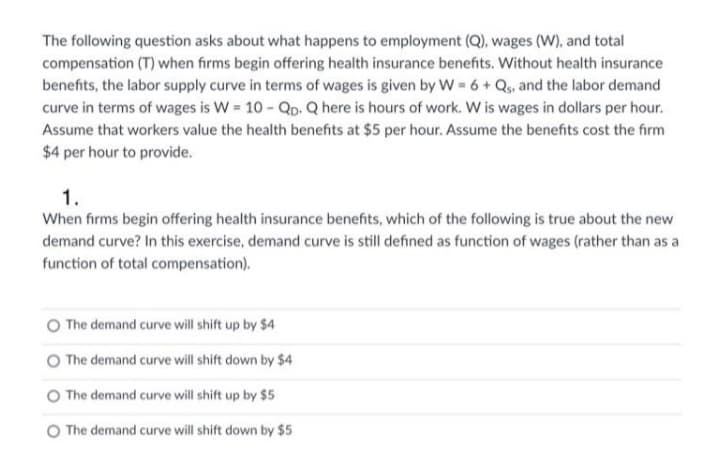The following question asks about what happens to employment (Q), wages (W), and total compensation (T) when firms begin offering health insurance benefits. Without health insurance benefits, the labor supply curve in terms of wages is given by W = 6+ Q, and the labor demand curve in terms of wages is W = 10 - Qo. Q here is hours of work. W is wages in dollars per hour. Assume that workers value the health benefits at $5 per hour. Assume the benefits cost the firm $4 per hour to provide. 1. When firms begin offering health insurance benefits, which of the following is true about the new demand curve? In this exercise, demand curve is still defined as function of wages (rather than as a function of total compensation). The demand curve will shift up by $4 O The demand curve will shift down by $4 The demand curve will shift up by $5 O The demand curve will shift down by $5
The following question asks about what happens to employment (Q), wages (W), and total compensation (T) when firms begin offering health insurance benefits. Without health insurance benefits, the labor supply curve in terms of wages is given by W = 6+ Q, and the labor demand curve in terms of wages is W = 10 - Qo. Q here is hours of work. W is wages in dollars per hour. Assume that workers value the health benefits at $5 per hour. Assume the benefits cost the firm $4 per hour to provide. 1. When firms begin offering health insurance benefits, which of the following is true about the new demand curve? In this exercise, demand curve is still defined as function of wages (rather than as a function of total compensation). The demand curve will shift up by $4 O The demand curve will shift down by $4 The demand curve will shift up by $5 O The demand curve will shift down by $5
Chapter18: Asymmetric Information
Section: Chapter Questions
Problem 18.9P
Related questions
Question

Transcribed Image Text:The following question asks about what happens to employment (Q), wages (W), and total
compensation (T) when firms begin offering health insurance benefits. Without health insurance
benefits, the labor supply curve in terms of wages is given by W 6 + Q, and the labor demand
curve in terms of wages is W = 10 - Qp. Q here is hours of work. W is wages in dollars per hour.
Assume that workers value the health benefits at $5 per hour. Assume the benefits cost the firm
$4 per hour to provide.
1.
When firms begin offering health insurance benefits, which of the following is true about the new
demand curve? In this exercise, demand curve is still defined as function of wages (rather than as a
function of total compensation).
The demand curve will shift up by $4
The demand curve will shift down by $4
O The demand curve will shift up by $5
O The demand curve will shift down by $5
Expert Solution
This question has been solved!
Explore an expertly crafted, step-by-step solution for a thorough understanding of key concepts.
Step by step
Solved in 2 steps with 2 images

Knowledge Booster
Learn more about
Need a deep-dive on the concept behind this application? Look no further. Learn more about this topic, economics and related others by exploring similar questions and additional content below.Recommended textbooks for you



Exploring Economics
Economics
ISBN:
9781544336329
Author:
Robert L. Sexton
Publisher:
SAGE Publications, Inc



Exploring Economics
Economics
ISBN:
9781544336329
Author:
Robert L. Sexton
Publisher:
SAGE Publications, Inc

Economics (MindTap Course List)
Economics
ISBN:
9781337617383
Author:
Roger A. Arnold
Publisher:
Cengage Learning

